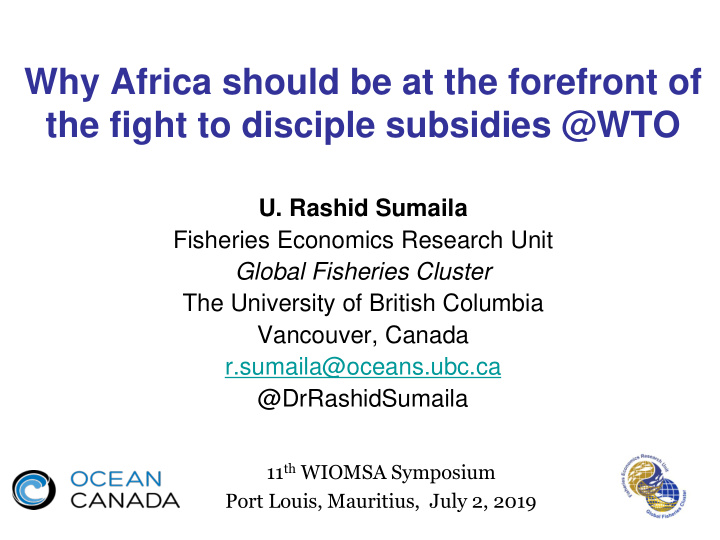



Why Africa should be at the forefront of the fight to disciple subsidies @WTO U. Rashid Sumaila Fisheries Economics Research Unit Global Fisheries Cluster The University of British Columbia Vancouver, Canada r.sumaila@oceans.ubc.ca @DrRashidSumaila 11 th WIOMSA Symposium Port Louis, Mauritius, July 2, 2019
B’cos people depend on nature No fish, no fishers, no fish dollars
B’cos we are ‘overtaking’ and ‘overpolluting’ Pauly et al. 1998; Jackson et al. 2001, Halpern et al. 2008; Abbott & Sumaila 2019
Northwest Africa: Changes in key fisheries variables 2.5 3.5 Fishing intensity Biomass 3.0 2.0 Biomass and catch (million tonnes) 2.5 Catch Fishing intensity 1.5 2.0 1.5 1.0 1.0 0.5 Biomass 0.5 0.0 0.0 1950 1960 1970 1980 1990 2000
B’cos declining oceans have serious human consequences
Enhance the state of fisheries by fixing the economics • Remove the incentive to overfish: – Improve national fisheries management; – Push for regional cooperative management; – Make illegal fishing unprofitable; – Buy insurance by creating marine reserves; – Remove and/or redirect harmful subsidies.
Blue economy = people & the ocean living in harmony Positive Feedback Marine People e.g., Subsidies Conservation Wellbeing Negative Feedback Blue economy: eliminate -ve, promote +ve feedbacks
Fisheries subsidies Fishery subsidies are financial payments, direct or indirect from public entities to the fishing sector, which reduces the cost of fishing and/or increases revenues. www.reefbase.org
Why should Africa be @ the forefront: B’cos subsidies … • are substantial – opportunity cost; • have trade impacts; • contribute to overcapacity, overfishing & IUU fishing; • Makes climate change bite harder; • They sabotage the SDGs. http://www.terradaily.com NOAA
How subsidies induce overfishing TC1 Cost-reducing subsidies MSY Bionomic Total cost of equilibrium BE 1 fishing effort (BE) (TC) MEY TR TR BE 2 & & TC TC ($) ( $) Max. rent TC2 Total Revenue (TR) TR E 4 Fishing effort (E) E 3 E 1 E 2 E 3 Fishing effort (E) Gordon Schaefer bioeconomic model
Categorizing & computing subsidies • Categorizing subsidies: – Beneficial subsidies (‘investment’ programs in fish stocks); – Capacity-enhancing (harmful) subsidies (‘disinvestment’ programs in fish stocks); – Ambiguous subsidies (programs may benefit or harm fish stocks). • Identified 13 subsidy types under the 3 categories above. Sumaila & Pauly (2006); Khan et al. (2006); Sumaila et al . (2010, 2016; 2019)
Estimating magnitude of subsidies • Our purpose: – Not to build a spaceship but to provide the most comprehensive global estimate of fisheries subsidies. • Methods for creating a global database – Collected data from all available sources; – Developed a methodology to fill data gaps. Sumaila & Pauly (2006); Khan et al. (2006); Sumaila et al . (2010, 2016; 2019)
Global subsidies by category Sumaila et al. (2019 in review )
Subsidies by region/continent Sumaila et al. (2019 in review )
Subsidies by type Sumaila et al. (2019 in review )
Groups & select countries’ subsidies Capacity Beneficial enhancing Ambiguous Total Country (USD million) (USD million) (USD million) (USD million) China 87 5,516 348 5,952 USA 2,216 1,260 77 3,553 Korea Rep. 1,635 1,506 41 3,182 Japan 534 2,123 161 2,817 Mauritius 4.7 1.4 ~0 6.1 EU 1,527 2,050 237 3,814 Africa 598 1,740 112 2,451 ACP 1,446 727 81 2,252 Latin American 800 1,370 134 2,304 LDC 348 913 58 1,319 Sumaila et al. (2019 in review )
Capacity-enhancing subsidies sabotage the SDGs • Undermines the viability of SSF; • Fuels gender inequality; • May leave future generations with only jellyfish. Schuhbauer, Sumaila et al. ( 2017 ) Marine Policy
Reduces food security & ggravates poverty 10 million t of fish lost implies lost of jobs & incomes Srinivasan, Sumaila et al. (2010)
Disadvantages developing country fishers 300 Subsidy per fishery worker (USD 000) 250 Developing countries 200 Developed 150 100 50 - Beneficial Capacity enhancing Ambiguous Teh & Sumaila, 2011; Sumaila et al . (2013) 17/07/2019 Global fisheries subsidies 19
There is one global ocean Subsidies fuels overfishing of the high seas The depletion of fish stocks in the high ` seas can influence the availability of fish to coastal fleets. Exclusive economic zones (light blue) and high seas (dark blue)
Subsidies fuel high seas fishing • Profitability of bottom trawlers operating in the deep and high seas ~10% of gross revenues; • Amount of subsidies received by these fleet estimated at ~25%. Sumaila et al . (2010) Marine Policy
Subsidies & “slave labor” fuel high seas fishing
Sumaila et al . (2015) White & Costello (2014) Close high seas High seas EEZ
Mean percentage change in maximum catch potential (MCP) and revenues in the 2050s relative to current status under RCP 8.5 scenario Standard % change in revenues is 35% Mean deviation % change in MCP -7.71 4.36 more than % change in MCP % change in revenues -10.37 4.20 Lam, Cheung, Reygondeau, Sumaila. (2016) Scientific Reports
Climate change is real: Implement the Paris Agreement Sumaila et al. (2019) Sc ience Advances
In conclusion: A need to be innovative with public funds https://oceancanada.org/o/wp- content/uploads/2018/09/rashid-interview-09-20- 2018.mp3
In conclusion: Africa seize the moral high ground on harmful subsidies @WTO Thanks for your attention! Thanks to WIOMSA!
Recommend
More recommend